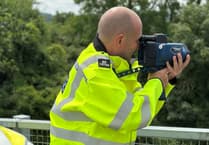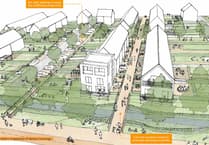The council is set to decide whether or not to make the closure of a residential Bath street to through traffic permanent — as it remains unpopular despite council claims that concerns are unfounded.
Wooden planters were installed on Southdown in Bath in November 2022 as one of Bath and North East Somerset Council’s three liveable neighbourhood trials, with the intention of preventing rat running and making it “safe and pleasant” for walkers and cyclists. Now — at the end of the trial period — the council is considering whether to make the restriction permanent, widening the pavement and installing bollards and a cycle lane to permanently block traffic.
The scheme — which has been controversial since it was installed — is opposed by 57% of the people on the street who responded to the council survey, while 40% supported it. 3% said they did not know.
Despite acknowledging the opposition to the scheme, a council statement said: “Several of the reasons for opposing the trial were not borne out in practice. This includes a perception by around half of respondents that the restriction would cause congestion on surrounding roads and several stating that it would lead to deteriorating air quality on those roads. Evidence from the monitoring reports show that this is not the outcome.”
The council’s traffic monitoring report found that traffic on Weston High Street had actually reduced after the scheme was implemented, with 3-4% less traffic — 180 to 220 cars — using the road each day. There was a 3-5% increase in traffic heading north east Anchor Road but the report stated this is “within typical variance of traffic flow volumes.” The report also said there had been a 75% increase in cycling on Southlands.
A decision on whether to make the scheme permanent will be made as a single member decision by council cabinet member for transport Manda Rigby. Decisions are also due on the council’s two other trial schemes on Church Road on the other side of Bath and Queen Charlton Lane near Whitchurch, which have received a higher level of public support. 75% of people living on Church Road backing the scheme and all but one of the people on Queen Charlton Lane supporting the measures there.
Ms Rigby said, “The trials are the outcome of significant consultation with communities as part of our liveable neighbourhoods programme and I look forward to considering the outcomes presented in these reports before a decision is made on whether to make these trials permanent under formal traffic regulation orders.
“Early in the new year, we will also consider proposals for five more traffic restrictions under the liveable neighbourhoods programme in the Lower Lansdown and Circus area, in the Lyme Road and Charmouth Road area, and in the New Sydney Place and Sydney Road area, all designed — in line with council policy — to prevent residential areas being used as short cuts and increase choice and safety for those that choose to walk, scoot or cycle.
“The long list of proposed interventions suggested by local communities across all the liveable neighbourhood areas is being reviewed by local councillors and considered as part of a full business case to be submitted to the West of England Combined Authority in early summer 2024.”
LDRS, John Wimperis



